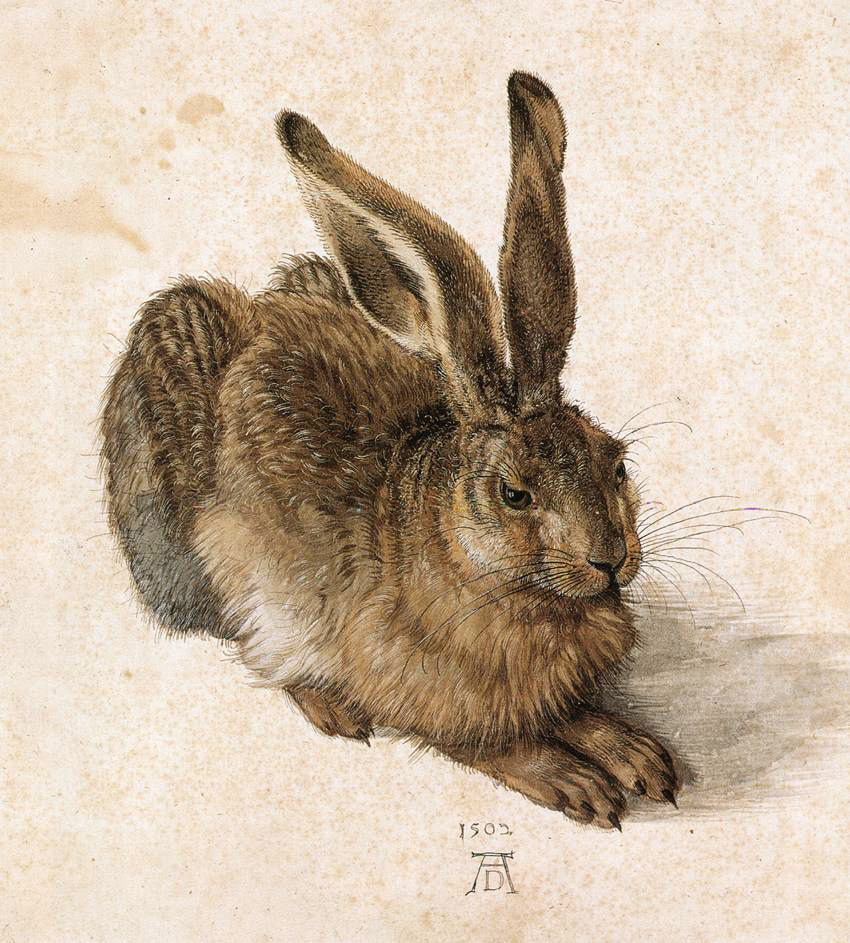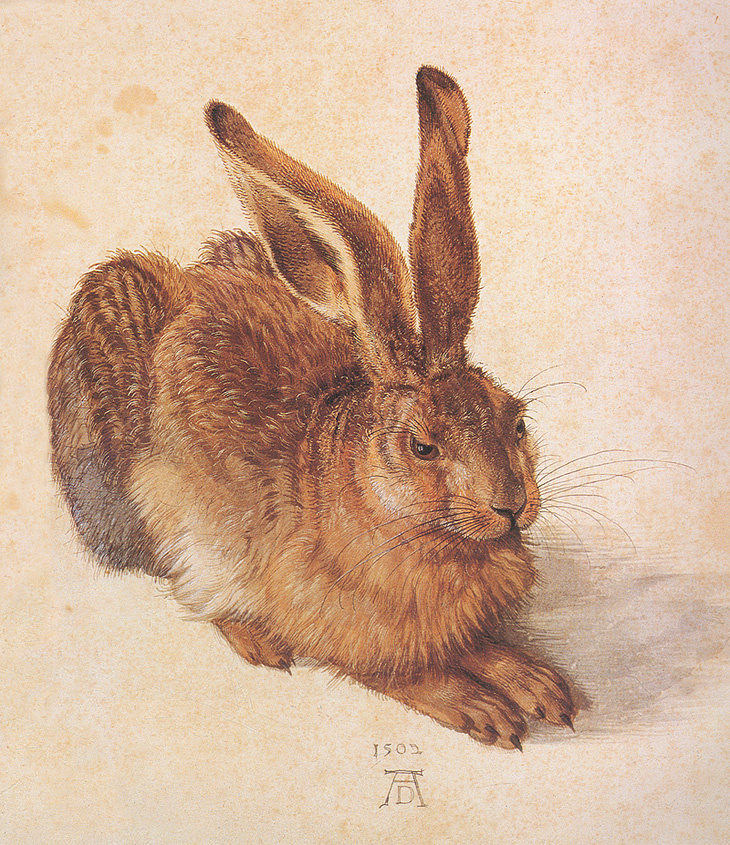log in
Enter site
Login to use Arthive functionality to the maximum
Young hare
Albrecht Dürer • Painting, 1502, 25.1×22.5 cm
Description of the artwork «Young hare»
“The eye, the sniffing nose, the hanging right and erect left ear, the variety of hairlines that is completely different on the ears than on the damp neck and back, not to mention the threadlike whiskers will remain unsurpassed. The highest degree of expressiveness remained unattainable, when the work appeals not only to the viewer’s eye, but also to the sense of touch to the same extent, so that it causes a desire to touch and ruffle the fur back and forth. (Kuno Mittelstädt, art critic, author of the Albrecht Dürer book)
Among the works of Albrecht Dürer, many naturalistic sketches have survived: a crab, possibly caught by the artist during his first trip to Italy, a huge beetle with bizarre horns, the wing of a dead roller in magical shades of blue, a gloomy walrus and even an exotic rhino (which Dürer has never seen)... But for some reason the most famous was the small work depicting an ordinary hare.
Conventionally, it can be called a watercolour, although the artist used gouache and whitewash along with watercolours. Dürer is known as one of the first artists who worked with watercolours, but his technique differed from the one we are used to — it is multi-layered and at the same time so elegantly graphic that it resembles drawing with coloured pencils on a transparent dark fill. Dürer depicted the hare’s fluffy fur in thousands of thin strokes — grey, brown, reddish-beige and whitish, short and long, flawlessly conveying the short hair on the animal’s ears, its long hair on the sides, and slightly curly hair on its neck and muzzle.
Dürer’s “bunny” hardly was the first hare in art — thanks to the richest symbolism associated with this animal, there are plenty of hares in painting, sculpture, and especially in miniature, where they can mean caution and cowardice, fertility and voluptuousness, and even (but only white ones) chastity. The novelty of the Dürer’s hare is that it is just a hare, an ordinary hare, symbolizing nothing, which, according to legend, was picked up and brought to the workshop by the artist himself. Looking closely, we can even make out the reflection of the window sash in the dark, bulging eye of the animal. However, some art critics believe that Dürer borrowed this technique from the Dutch masters, who left the reflection of the window either in a convex mirror, or in a glass, or in a shiny helmet.
Judging by the fact that the Young Hare is one of the first signed and dated drawings by Dürer, the artist himself appreciated his work. The fans of the artist’s talent also appreciated it: in 1519, the drawing was acquired by the Nuremberg collector Willibald Imhof, and, probably, it was he who provided access for its multiple copying. Currently, 13 variants of the artwork are known, including those with a fake signature by Dürer, which were made mainly in the 16th century. Hans Hoffmann’s (1530—1591) “Durer’s Fake Hare” is dated 1528, the year of Durer’s death. This is not the only variation of the work by this artist.
In 1588, Dürer’s drawing entered the collection of Emperor Rudolf II, in 1783 it appeared in the court library. Later it became the property of Duke Albert of Saxe-Teschen and, finally, it safely settled in the repository of the Albertina Museum. Yes, exactly in the repository, because, like for most watercolours and pastels, light is dangerous for The Young Hare, therefore the painting is extremely rare in public, unlike its most accurate copy.
Author: Oksana Sanzharova
Among the works of Albrecht Dürer, many naturalistic sketches have survived: a crab, possibly caught by the artist during his first trip to Italy, a huge beetle with bizarre horns, the wing of a dead roller in magical shades of blue, a gloomy walrus and even an exotic rhino (which Dürer has never seen)... But for some reason the most famous was the small work depicting an ordinary hare.
Conventionally, it can be called a watercolour, although the artist used gouache and whitewash along with watercolours. Dürer is known as one of the first artists who worked with watercolours, but his technique differed from the one we are used to — it is multi-layered and at the same time so elegantly graphic that it resembles drawing with coloured pencils on a transparent dark fill. Dürer depicted the hare’s fluffy fur in thousands of thin strokes — grey, brown, reddish-beige and whitish, short and long, flawlessly conveying the short hair on the animal’s ears, its long hair on the sides, and slightly curly hair on its neck and muzzle.
Dürer’s “bunny” hardly was the first hare in art — thanks to the richest symbolism associated with this animal, there are plenty of hares in painting, sculpture, and especially in miniature, where they can mean caution and cowardice, fertility and voluptuousness, and even (but only white ones) chastity. The novelty of the Dürer’s hare is that it is just a hare, an ordinary hare, symbolizing nothing, which, according to legend, was picked up and brought to the workshop by the artist himself. Looking closely, we can even make out the reflection of the window sash in the dark, bulging eye of the animal. However, some art critics believe that Dürer borrowed this technique from the Dutch masters, who left the reflection of the window either in a convex mirror, or in a glass, or in a shiny helmet.
Judging by the fact that the Young Hare is one of the first signed and dated drawings by Dürer, the artist himself appreciated his work. The fans of the artist’s talent also appreciated it: in 1519, the drawing was acquired by the Nuremberg collector Willibald Imhof, and, probably, it was he who provided access for its multiple copying. Currently, 13 variants of the artwork are known, including those with a fake signature by Dürer, which were made mainly in the 16th century. Hans Hoffmann’s (1530—1591) “Durer’s Fake Hare” is dated 1528, the year of Durer’s death. This is not the only variation of the work by this artist.
In 1588, Dürer’s drawing entered the collection of Emperor Rudolf II, in 1783 it appeared in the court library. Later it became the property of Duke Albert of Saxe-Teschen and, finally, it safely settled in the repository of the Albertina Museum. Yes, exactly in the repository, because, like for most watercolours and pastels, light is dangerous for The Young Hare, therefore the painting is extremely rare in public, unlike its most accurate copy.
Author: Oksana Sanzharova



